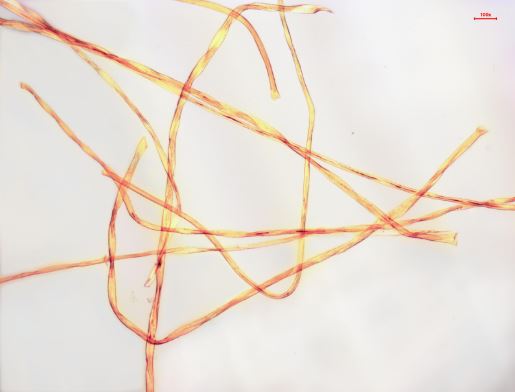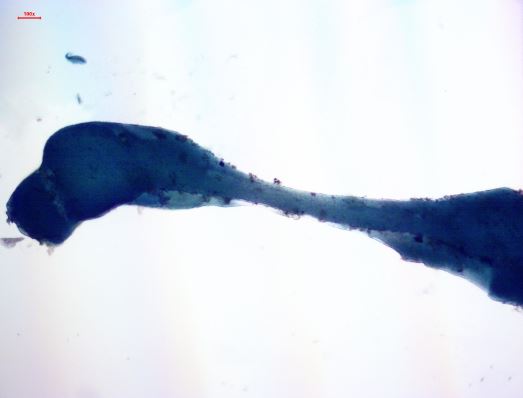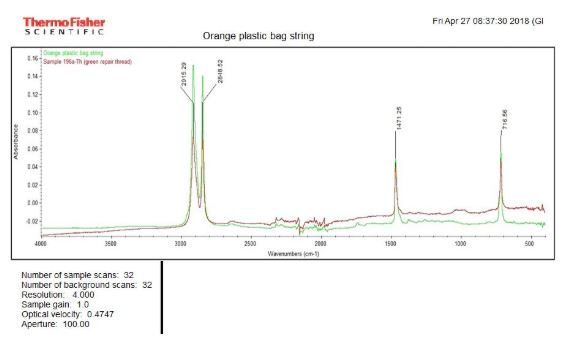After the departure of beading expert Hlengi Dube, work continues on the survey of the Zulu ensemble components in order to pair the cultural and structural examination with a scientific materials study. With the insights into the importance of materials choice afforded by this consultation, I sought to characterize as many materials as possible using Fourier Transform Infrared (FTIR) spectroscopy, X-Ray Fluorescence (XRF) spectroscopy, stereomicroscopy, and Polarized Light Microscopy (PLM).
Of particular concern and interest was whether or not everything described in English by the Zulu as “cotton” was indeed cotton. This was achieved by mounting minimally-destructive samples on permanent slides and examining them under a polarized light microscope. Most of the thread and fabric were cotton, but a few instances of bast fibers and manufactured materials were observed. After training my eye to this, I am now fairly certain that I can recognize cotton macroscopically without the use of the microscope.

The Zeiss Axioskop Polarized Light Microscope at the David and Susan Goode Center for Advanced Study in Art Conservation.

Photomicrograph of a cotton sample from a Zulu man’s beaded apron (2013.195c) at 100x magnification.
One very interesting observation made over the course of this process was the discovery of repairs made with plastic thread. As its appearance under the microscope was unusual, analysis with FTIR was used to identify the material as low-density polyethylene (LDPE). With Hlengi there, I was able to determine that sometimes repairs, being made with available materials, were completed with strings pulled from plastic produce bags. A quick experiment with a netted-polyethylene bag of oranges from the supermarket confirmed that this was indeed possible, and spectroscopy of the bag was consistent with material sampled from the repair thread. This is an interesting example of observations made in the laboratory being confirmed by those made in the field.

Photomicrograph of Sample 196a-Th at 100x showing the a sample of the polyethylene-repair thread through the beading of a Zulu woman’s front skirt (2013.196a).

FTIR spectrum of Sample 196a-Th overlaid with the spectrum from a sample of plastic string taken from a polyethylene produce bag.
One other important data generated by this project include the insights that Hlengi provided into the dating the pieces. In conjunction with observations about “hands”—i.e. the stitch type, tension, and skill of the beadworker—she described how subtle variations in the color of the beads—especially in the blue and green beads—were clear indicators of relative date. While “moss-green” beads were likely to date to an earlier time (1920s–1940s), “true-green” beads were likely to be later (1950s–1960s); and this pattern was particularly evident on the female ensemble. XRF data was collected in the hopes of correlating the elemental composition of the beads to a relative date. To complicate matters, beaded aprons, necklaces, bandoliers, and other embellishments are traditionally disassembled with some regularity, and the beading is reconstituted on a separate textile or object, used for repairs, or made into fodder for the art market. The interpretation of this large body of data remains a daunting task that I hope to write about later.
Stay tuned for updates on this exciting project as we consider the challenges of mounting and the culturally-appropriate display of these ensembles in collaboration with Ms. Dube and our curatorial team. And come see these exceptional ensembles when they are installed in the gallery in late March!